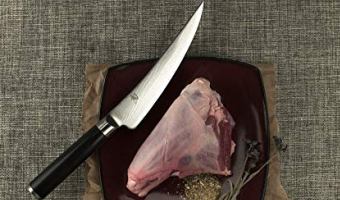
Bones have a long, thin, flexible blade with sharp points that make it easier and safer to thread meat. The blade is designed to cut through ligaments and connective tissue to remove raw meat from the bone.
The best knife for boning must be extremely sharp, and the harder the blade, the sharper. Dull blades can tear meat from bones instead of cutting it, this affects both cooking and presentation.
Blunt knives are dangerous because they require more force to cut through the meat, meaning you can easily lose control of the knife.
How to choose a boning knife
The type of bone knife you use will depend largely on the work you need and the type of meat you will handle. When choosing a boning knife, you will have the following options:
1. Design of blade:
- Curved: The curve of a fillet or bone knife is great for removing the skin of a fish in one swipe, as well as making long, clean strokes through the skin. This shape can also make some delicate work, such as filling a quail, easier because the angle of the curve allows for more efficient maneuverability around small spaces.
- Straight: This is easier to remove large blocks of meat, such as beef. Interestingly, many traditional Japanese fillet knives are straight. Straight blades are said to help cut and sculpt better. In the hands of an expert, these knives are ideal for high speed cuts.
- Flexible: The ability to blend and bend better for complex jobs as it allows the knife to cut lighter rounded corners and difficult shapes.
- Rigid: Tougher, the meat is thicker and causes a less powerful knife to bend and deflect. Hard blades can be used to cut through and cut wide sections.
- Thin: Not all thin blades are necessarily flexible. Sometimes, thinner blades are needed to cut around smaller corners. The thinner blade also passes through the flesh with less resistance, causing less damage to thinner meat.
- Wide: Wide, sturdy knives are definitely needed to divide thick meat.
2. Size:
This will depend on the type of meat being cut.
3. Handle :
- Handles: The handle needs to be comfortable in your hand. However, some jobs require a strong grip force when forced to force meat, while others will be used as scalpels to perform precise incisions.
- Tang: This refers to thin metal fragments that run through the handle. It is the same metal that makes up the blade and is continuous. Full tang means that the metal runs to the end of the handle, then is built around it. This is a safer handle than the partial tang handle, in which metal stops midway. Some knives are made entirely from a continuous piece of metal, including the handle. This is exceptionally strong.
- Material: The wooden handle looks stylish but can warp when left in water. Handles are hard metal, but some people find them cold and unsafe. A good comprehensive material is polypropylene. This synthetic hard plastic can have the appearance of wood without any maintenance problems.
How to clean a bone knife
As with most kitchen knives, it’s best to clean and dry the knife by hand immediately after use. Although most knives are made of stainless steel and therefore highly resistant to rust, water can inflate and warp wooden handles, soaking into cracks – very dangerous for cleaning and damage the chrome coating to prevent rust.




